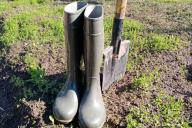Mulching beds is a procedure that is definitely useful, but this does not mean that it is equally applicable to all fruit and vegetable crops.
For example, when it comes to garlic and onions, you can even cause harm if you don’t know how to use this material correctly.
Fallen leaves, straw, hay, and pine branches are most often used. But you shouldn't get carried away, otherwise soil contamination will be unavoidable.
1. Fresh straw
There are frequent cases when after its use a dangerous disease spreads - fusarium. The disease is popularly called bottom rot.
A sign of bulb damage, in addition to rotting, is a pink fungal coating. After infection, the development of the root system stops, the feathers turn yellow, and the plant slowly dies.

Therefore, the straw needs to be treated with Trichoderma.
2. Poplar leaves
The reason is that in such a protective layer, comfortable conditions can be created for the development of the poplar fly, and this material also transfers rust to the garden bed.
In this case, brown spots appear, feathers die off, bulbs do not develop, the disease is difficult to treat, and the disease spreads quite quickly.
It is recommended to use oak, birch or maple leaves to cover onions and garlic.








